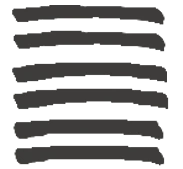ARTICLE

Strange relations between I Ching and DNA's structure.
The DNA is a large high-weighted molecule of 51.18" long, seen as a twisted double thread or spiraled staircase. It's composed by two acid and sugar chains, alternated and combined at intervals: thymine (T) always paired with adenine (A), and cytosine (C) always paired with guanine (G). The paired components are grouped and create a sequence which produces aminoacids, the bases for proteins.
The DNA has also been described as a cosmic serpent "that lives in water and emits photons, like an aquatic dragon spitting fire", emitting and absorbing pulses like a system in communication with major organisms.
| I Ching - ADN parallel characteristics | ||
|---|---|---|
| I CHING | DNA | |
| polar expression | yin - yang | up - down symmetry |
| based on 2 | structuring principles (yin, yang) | acid and sugar chains |
| based on 4 | yin-yang combination bigrams: older yin, older yang, young yin, young yang | acid-sugar combination pairs: T - A and C - G |
| based on 3 | trigram | codon (3 pairs when combined) |
| based on 64 | hexagrams (combination of trigrams) | there are 64 codons |
| reading | from below to above (when trigrams are depicted as strokes) | pairs as codons in a single direction |
| punctuations in sequences |
| starts and stops |
| Source: Reading the Green Language of Light (Part Two). TM doesn't agree with the rest of references mentioned in the source, especially those lines related to the way words are considered. About the last one, TM published an article on medium.com mentioning the sequence as a way to deepen into predictive readings. | ||
I Ching is an analogy of the ways of all things in the creation, of all processes and reflections in nature. The word I was initially a pictogram for lizard or cosmic dragon, and is usually translated as change, to describe the evolution of patterns (yin-yang) and rhythms in chi (vital energy) over time.
Change is unchangeable: life is unfolded throughout time by going through changes. I Ching offers a panorama of reality in change itself by associating three transformative sequences to Fu Hsi's trigrams:
an exponential sequence

 Life profussion inside of a geometric view of an expanding universe. What it is, is expressed by 2 (ying and yang), and produces 4 (brigrams), 8 (trigrams) and 64 (hexagrams).
Life profussion inside of a geometric view of an expanding universe. What it is, is expressed by 2 (ying and yang), and produces 4 (brigrams), 8 (trigrams) and 64 (hexagrams).




a heavenly sequence

 Solstices and equinoxes are associated to trigrams. In the ordering assigned by Fu Hsi, Chien is Summer (Heaven, metal, South in the Western world), Li is Autumn (flame, fire, East), Kun is Winter (Earth, North), and K'an is Spring (abyss, water, West).
Solstices and equinoxes are associated to trigrams. In the ordering assigned by Fu Hsi, Chien is Summer (Heaven, metal, South in the Western world), Li is Autumn (flame, fire, East), Kun is Winter (Earth, North), and K'an is Spring (abyss, water, West).
 | |
 |  |
 | |
an earthly sequence

 It describes chi's natural unfolding during 12 annual seasons. Light and darkness increase or decrease as energy enters from Earth or the base of the hexagrams: from Kun towards Chien, to come back to Kun and so on, cyclicly... Yang hemicycle starts in Fu (Return) and ends in Chien, and yin hemicycle starts in Kou (Coupling) and ends in Kun.
It describes chi's natural unfolding during 12 annual seasons. Light and darkness increase or decrease as energy enters from Earth or the base of the hexagrams: from Kun towards Chien, to come back to Kun and so on, cyclicly... Yang hemicycle starts in Fu (Return) and ends in Chien, and yin hemicycle starts in Kou (Coupling) and ends in Kun.












In I Ching as much as in the DNA's structure, the changes in sequences seem to happen according to some predictable ordering: cosmos, Earth, geometry, genetics... But the oracle is a special reference because it allows seeing through the changing lines the chance coming along with chi's fluctuations in the empty. Mutations reflect those emitted and received energies, as they impulse or are about to impulse new actions in upcoming sequences of situations. Without a doubt, the nature of change is an enigma, and we found in I Ching a graphic way to represent it.





Comments
Join and leave a message. I always answer personally, and as soon as possible.